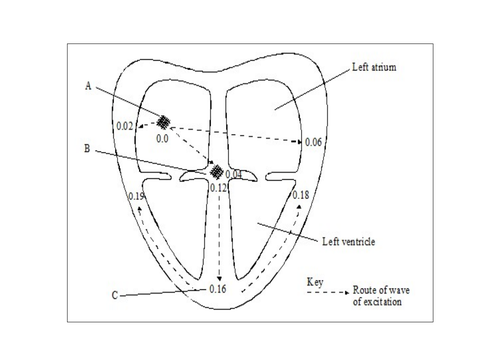




This engaging and fully-resourced lesson looks at the myogenic nature of cardiac muscle and explores the roles of the SAN, AVN and Purkyne tissue (bundle of His) in the initiation and control of heart action. The PowerPoint and accompanying resources have been designed to cover point 3.1.2 (g) of the OCR A-level Biology A specification.
The lesson begins with the introduction of the SAN as the natural pacemaker and then time is given to study each step of the conduction of the impulse as it spreads away from the myogenic tissue in a wave of excitation. The lesson has been written to make clear links to the cardiac cycle and the structure of the heart and students are challenged on their knowledge of this system from topic 3.1.2. Moving forwards, students are encouraged to consider why a delay would occur at the AVN and then they will learn that the impulse is conducted along the Bundle of His to the apex so that the contraction of the ventricles can happen from the bottom upwards. The structure of the cardiac muscle cells is discussed and the final task of the lesson challenges the students to describe the conducting tissue, with an emphasis on the use of key terminology
Due to the detailed nature of this lesson, it is estimated that it will take about 2 hours of A-level teaching time to cover the detail
Get this resource as part of a bundle and save up to 44%
A bundle is a package of resources grouped together to teach a particular topic, or a series of lessons, in one place.
Module 3: Exchange and transport (OCR A-level Biology A)
This bundle contains 18 detailed and engaging lessons which cover the following specification points in module 3 (Exchange and transport) of the OCR A-level Biology A specification: 3.1.1: Exchange surfaces * The need for specialised exchange surfaces * The features of an efficient exchange surface * The structures and functions of the components of the mammalian gaseous exchange system * The mechanism of ventilation in mammals * The mechanisms of ventilation and gas exchange in bony fish and insects 3.1.2: Transport in animals * The double, closed circulatory system in mammals * The structure and functions of arteries, arterioles, capillaries, venules and veins * The formation of tissue fluid from plasma * The external and internal structure of the heart * The cardiac cycle * How heart action is initiated and coordinated * The use and interpretation of ECG traces * The role of haemoglobin in transporting oxygen and carbon dioxide * The oxygen dissociation curve for foetal and adult haemoglobin 3.1.3: Transport in plants * The structure and function of the vascular systems in the roots, stems and leaves * The transport of water into the plant, through the plant and to the air surrounding the leaves * The mechanism of translocation As well as the detailed A-level Biology content of the PowerPoint slides, the resources contain a wide range of tasks including guided discussion points, exam-style questions and quiz competitions which will engage and motivate the students
Module 3.1.2: Transport in animals (OCR A-level Biology)
Each of the 9 lessons in this bundle are fully-resourced and have been designed to cover the content as detailed in module 3.1.2 (Transport in animals) of the OCR A-Level Biology A specification. The specification points that are covered within these lessons include: * A double, closed circulatory system * The structure and function of arteries, arterioles, capillaries, venules and veins * The formation of tissue fluid from plasma * The internal and external structure of the mammalian heart * The cardiac cycle * How heart action is initiated and coordinated * The use and interpretation of ECGs * The role of haemoglobin in transporting oxygen and carbon dioxide * The dissociation curve for foetal and adult haemoglobin * The Bohr effect The lessons have been written to include a wide range of activities and numerous understanding and prior knowledge checks so students can assess their progress against the current topic as well as be challenged to make links to other topics within this topic and earlier topics If you would like to see the quality of the lessons, download the formation of tissue fluid. heart action and ECGs lessons as these are free
Something went wrong, please try again later.
WOW! thanks so much for sharing a brilliant free resource!
Report this resourceto let us know if it violates our terms and conditions.
Our customer service team will review your report and will be in touch.